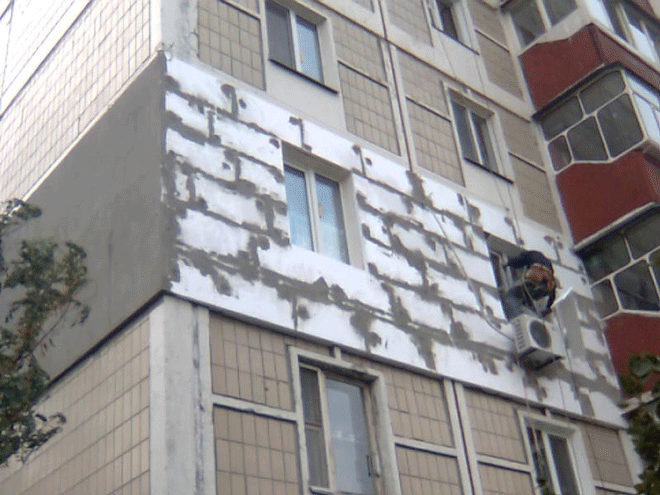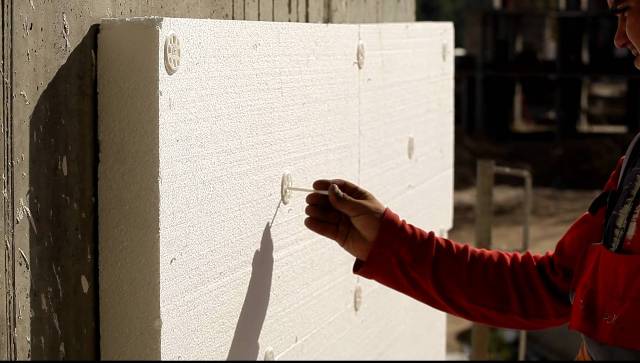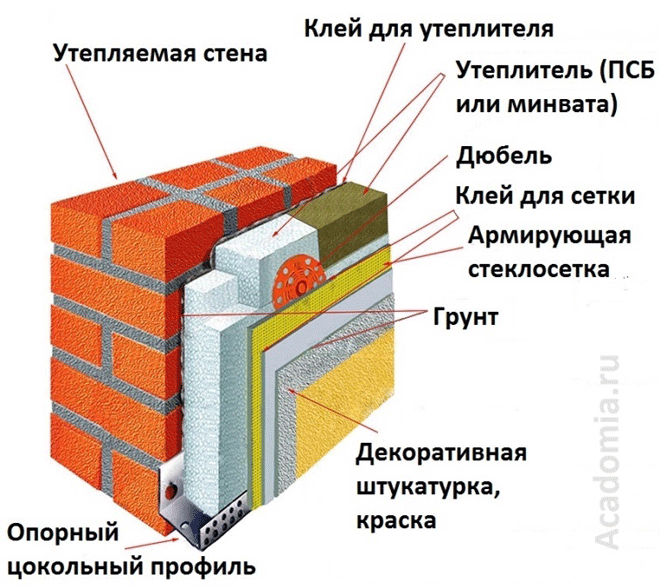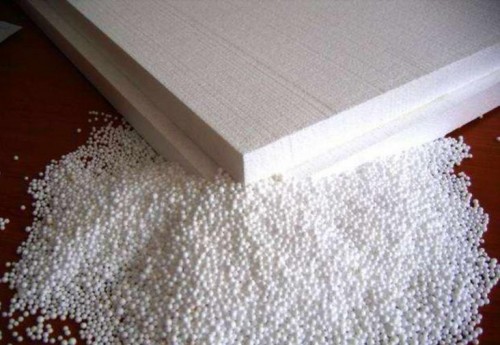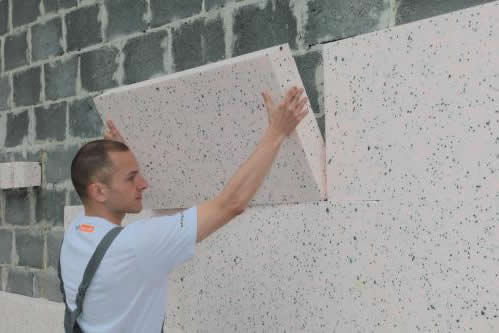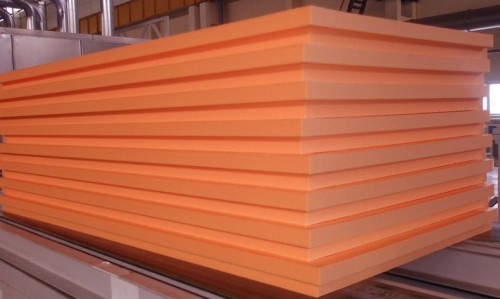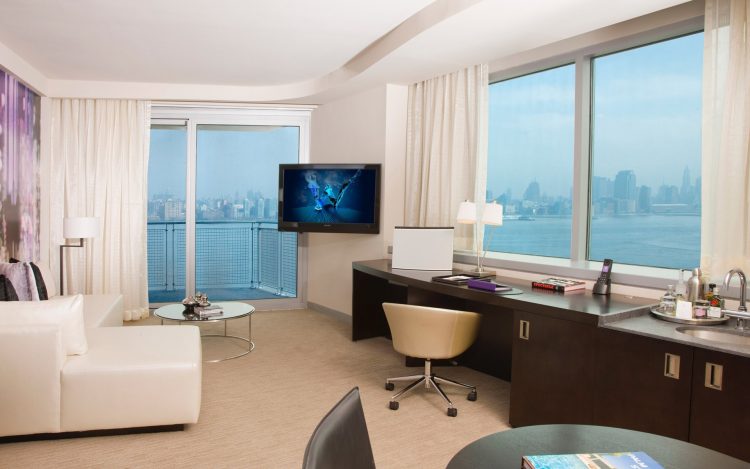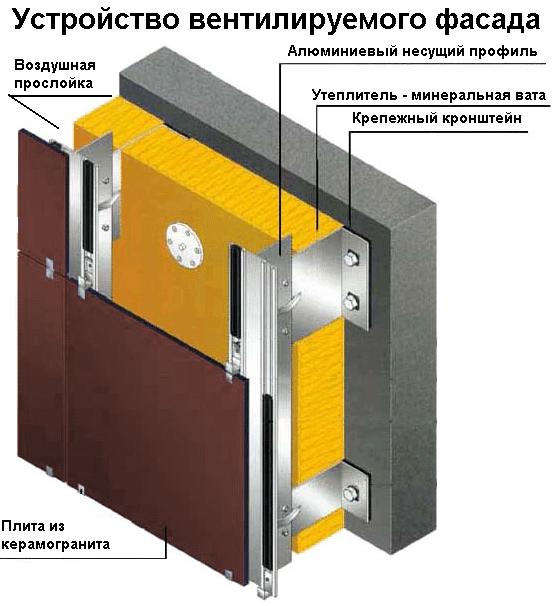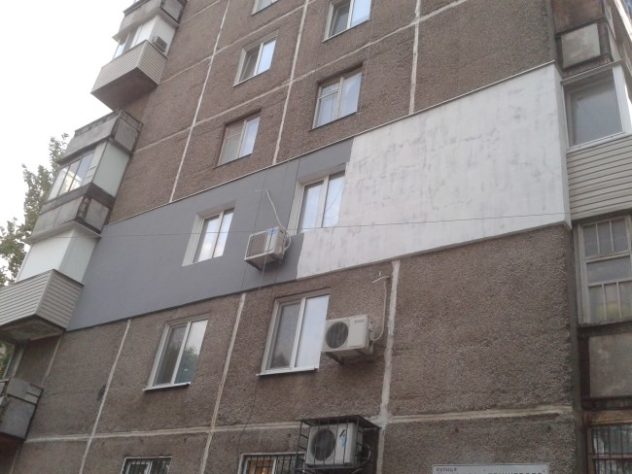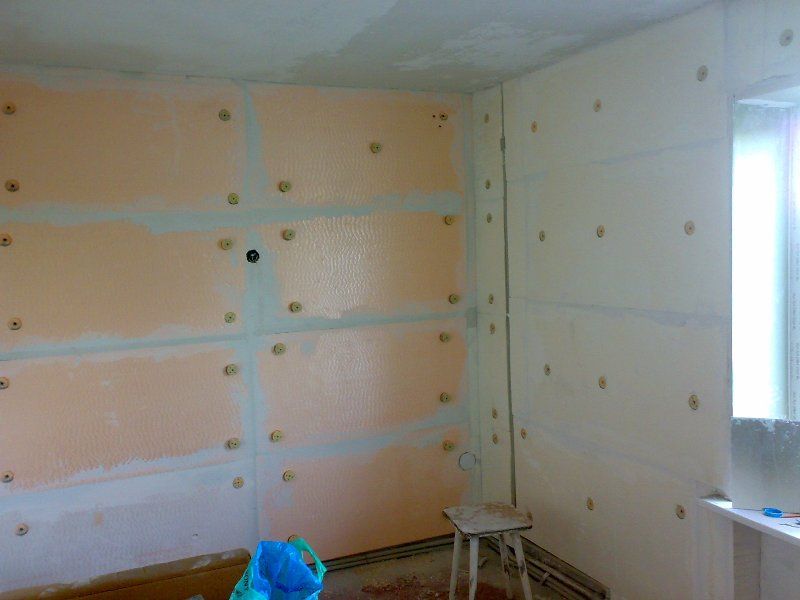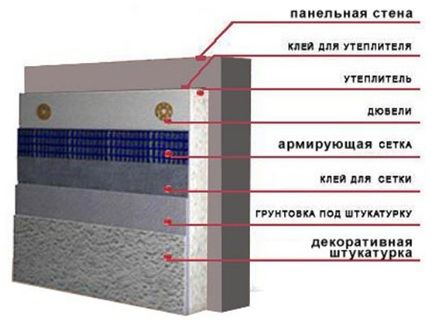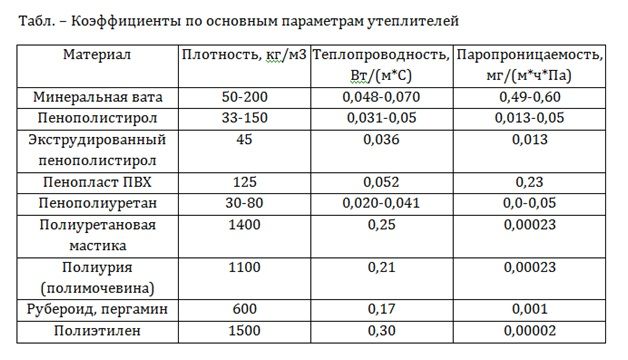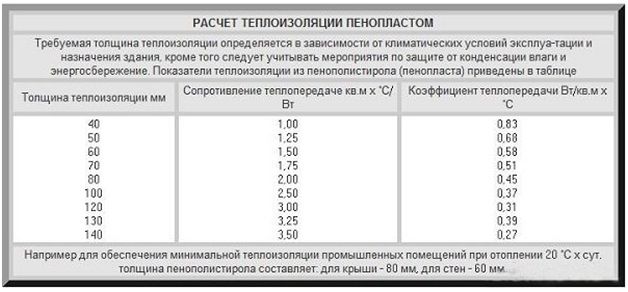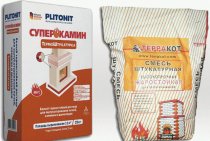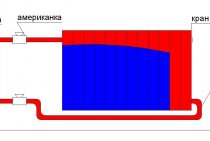Options for insulating the walls of panel houses
Modern technologies present two options for insulating the surfaces of the walls of an apartment building: from the inside and outside. Both options will solve the problem of low room temperature and rapid heat loss. In prefabricated houses, more cast-iron radiators with excellent heating qualities were installed, but due to the thinness of the walls and their direct contact with frosty air, the efficiency of radiators is significantly reduced.
Both options are suitable for this, but their implementation is radically different, so you need to determine a simpler and more economical one that you can do yourself.
External insulation
Insulation of the facade of a panel house is carried out in the following steps:
Preparatory stage
Surface preparation of the facade is necessary - the end walls of the panel house are leveled, the plates are cleaned of plaque
It is also important to seal voids, cracks, and panel joints are sealed. If necessary, it is worth laying a sealant between the joints, while a special mastic is used to seal the cracks
Roughness of the surface of the walls within two centimeters is allowed - such a deviation can not be closed. When all materials are dry, the wall is impregnated with a universal primer, which is applied using a sprayer or roller.
Insulation installation
Since in the vast majority of cases it is foam plastic that is used for thermal insulation of panel houses, it is worth considering the installation technology of this insulation. You can fix the foam by the following methods: put the plates on glue, fasten with dowels, or connect these two options, this is the most reliable choice. The direction of gluing is from bottom to top. In this case, pasting begins with the installation of the starting bar.
After that, we begin to apply glue to the surface of the panel house - the technologies used directly depend on the quality of the walls. If they are even, then you can apply glue with a comb. If, as is often the case, the walls are uneven, then the glue simply pounces onto the surface.
It is important to carefully fill the seams with glue. All this allows you to get rid of voids under the heat insulator
It is not necessary to apply glue to the foam.
The option when the glue is applied to the foam, and not to the house, is not suitable in this case, since the voids under the insulation will become natural cold bridges, which will reduce the effectiveness of the entire event as a whole.
Styrofoam is applied to the glue layer and pressed well. After gluing all the plates, you need to leave them alone for a few days. During this period, the adhesive solution will dry and shrink, after which it will be possible to perform the next stage of work. As for fixing the plates with dowels, you can choose plastic fungi. This is due to the lightness and low strength of the foam - such fasteners will save the facade from unnecessary heat loss.
As for the dowel caps, they must be covered with an adhesive mixture. All the irregularities remaining after the glue has dried can be removed with ordinary sandpaper.
Reinforcement preparation
The fragility of the foam is a serious drawback, so the insulation needs to be reinforced - it is enough to glue a thin mesh. Such protection should prevent the destruction of the foam due to atmospheric phenomena and other adverse factors.
Preparation for reinforcement is as follows: first, the corners are pasted over, after which you can proceed to pasting the walls themselves. To simplify the process, grids with ready-made corners are used, which minimizes time. If there are no such grids, then you will have to make corners from a regular grid.It is enough to cut off a long strip 30 centimeters wide and bend it at an angle - this design is pressed against the corner of the house smeared with glue. In general, cutting the mesh into fragments greatly simplifies the installation itself, which makes it possible to successively cover the areas smeared with glue with fragments. At the same time, the mesh should overlap at the junction.
After gluing the mesh, it is necessary to wait for the glue to dry, after which it remains to clean the excess solution with a plastic grater and remove irregularities.
Finishing
Before finishing, a leveling layer is applied to the entire treated facade. After that, it is necessary to apply a primer and a layer of plaster. The final step is to paint the wall, preferably in a color that will not stand out too much against the background of the main color of a multi-storey panel house.
Heaters
The modern construction market offers a frighteningly large selection of thermal insulation materials. The "ordinary" man in the street, not familiar with the specifics of the work, the head is spinning from such a variety. This is what unscrupulous sellers use, instilling the idea "the more expensive, the better." Today we will not consider all options for insulating the exterior walls of the house, but we will talk about the most inexpensive, high-quality and proven materials over the years.
Styrofoam
Among the most popular heaters, foam plastic occupies a special place. This is an inexpensive material that regularly performs the function assigned to it. It is perfect for outdoor insulation, as it provides 100% thermal insulation, regardless of air humidity and temperature changes.
This material is non-toxic and fireproof, however, a reservation should be made here. The foam itself does not burn, but melts and at the same time emits black acrid smoke, which is hazardous to health. But if you follow the safety measures, it will last a long time and faithfully. In confirmation of the words about non-toxicity and harmlessness to health, the fact that even children's goods and food products are packed in polystyrene foam.
Polyfoam is not affected by mold, fungi and insects. It does not deteriorate, does not swell and does not shrink, retaining its original shape. The service life of the material is from 20 to 50 years, depending on the quality.
External insulation of the walls of the house with foam plastic allows not only to protect the interior from the vagaries of the weather, but also transforms the house from the outside. The material creates a very convenient surface for finishing, ranging from relief plaster, ending with siding or slabs.
Working with foam plastic is quick and easy, it is enough to have basic skills and equipment.
Stages of insulation of the outer walls of the house with foam:
- Prepare the walls by cleaning them of dust and dirt with a construction brush. If there are cracks and chips, repair them with plaster so that the foam sticks well.
- Glue the foam plastic with a special compound on a pre-primed wall. You need to glue the sheets in a checkerboard pattern, tightly pressing against each other. To keep the material well, additionally fix it with plastic dowels.
- Install fiberglass mesh over the boards. To do this, apply a thick layer of glue of 5 mm to the sheets and “drown” the mesh in it.
- It remains only to plaster the surface, cover it with facade paint or perform any other finish.
Penoplex
Today you can often hear advertisements for high-quality and reliable foam insulation, which is why many believe that this is the name of the material. In fact, the material is called extruded polystyrene foam, and it is produced under the Penoplex brand.
Extruded polystyrene foam is used for internal and external insulation of houses of any type. Today it is one of the most popular materials, and this is due to its excellent performance.
Penoplex advantages:
- environmental friendliness;
- low thermal conductivity;
- high density;
- retains heat better than foam;
- high strength;
- high density;
- low vapor permeability;
- absolute fire safety (ignition temperature 500C, which is unrealistic at home);
- durability;
- ease of work with the material;
- relatively low cost, which quickly pays off.
Unfortunately, ideal building materials do not yet exist, therefore, even with such a large list of advantages, penoplex also has disadvantages. The most obvious is poor adhesion. Since the material is very dense, it does not absorb adhesives well, so it is difficult to stick it to a vertical surface. To do this, additional fixation is made with dowels, however, most builders recommend using penoplex for internal insulation.
External insulation of the walls of the house with foam plastic is best done in the area of \u200b\u200bthe basement, since even additional fixation of the material will not insure it from damage. In other words, it starts to fall off very quickly and spoils the appearance of the building. In the area of \u200b\u200bthe plinths, you can make a ventilation space or use an outer layer of waterproofing to prevent wetting and destruction of the adhesive layer.
https://youtube.com/watch?v=KA5pPEDRxwY
Wall insulation from the inside in a corner apartment
If you have dealt with buying or selling apartments, then you have noticed that buyers are not very fond of corner apartments or rooms. What is it connected with? Although in summer such an apartment is much easier to ventilate, the view from the windows opens on two or even three sides.
But there is one significant downside. Very often, with the advent of frost, residents of corner apartments suffer from insufficient heat. If the temperature outside is around zero, and the heating season has not yet begun, uncomfortable conditions are created inside such an apartment. Dampness appears in the corners, the windows fog up, the floor becomes cold, and the bed is damp.
The main reason for this is the presence of three walls that have an exit to the outside, and therefore are most affected by low temperatures. In winter, even with central heating, the situation only gets worse.
The walls can freeze completely, especially in the corners, the interior decoration will begin to fall off, mold and fungus will appear. Being in such an apartment will not only be uncomfortable, but also not safe, especially for children. After all, they are most susceptible to the appearance of diseases, the cause of which is high humidity.
What to do in such a situation? Many try to install additional heating radiators, but this, most often, does not solve the problem or solves it, but not completely. Dampness is displaced under the ceiling, forming places where mold accumulates.
What is the right thing to do in such a situation? The best solution is to try to insulate the walls. How can I do that? How to carry out internal insulation? We'll try to figure it out now. What is the best way to insulate the walls of the apartment from the inside? First, let's look at what insulation materials exist.
Types of insulation
The choice of what material is better to insulate the walls from the outside is influenced by:
- location of the panel house in a certain climatic region,
- rainfall, wind strength and speed,
- allocated budget for the insulation of a panel house,
- other individual factors.
The estimate and project for the work is usually compiled by the management company or HOA. And the team of industrial climbers directly performs the process of warming from the outside.
For panel houses, two types of insulation are mainly used:
Mineral wool
For outdoor work, it is convenient to work with mineral wool slabs, which are produced by various manufacturers. She has good performance in terms of basic characteristics, including thermal conductivity. However, care must be taken to ensure that mineral wool does not get wet, otherwise it will lose its thermal insulation properties.To do this, a vapor-permeable membrane is laid under the insulation layer, which will protect it from vapors.
When finishing with a ventilated facade, condensate from the walls of the house will be removed due to the air gap and the membrane can be omitted.
Styrofoam
Differs in ease, simplicity when laying plates on a wall. It also has good parameters for heat and sound insulation.
For outdoor work, it is important to use a material that does not support self-combustion. Manufacturers mark it with the G1 marking, however, the results of many tests confirm that the foam is flammable, and this name does not meet the requirements of GOST 30244-94
When buying a heater, be sure to ask the seller for product certificates.
The insulation of a panel house from the outside is limited by the thickness of the insulating material. The maximum value of foam plastic thickness for walls is calculated using special formulas, taking into account average temperatures in a certain climatic region and the purpose of the building (residential, public, industrial).
Insulation options
Insulation of a panel house from the outside allows you to stop the outflow of heat through the concrete. An additional layer of thermal insulation will protect against the damaging effects of external factors. On the market today you can find many materials that can be used for insulation inside or outside.
Warming inside
For a panel house, insulation from the inside will only make the situation worse. This is due to the movement of the dew point, which will move closer to the inside of the wall. In practice, this means that moisture will accumulate in the walls with even greater force - both the wall and the insulation will get wet, so the life of the facade will be significantly reduced. To avoid such a situation, and at the same time reduce the usable area of the apartment and destroy the design, it is worth giving preference to warming the panel house from the outside.
Warming outside
The difficulty lies in the fact that the insulation of a panel house with a large number of floors is possible only with the help of climbing equipment. It is clear that it is almost impossible to get money to pay specialists and purchase building materials from public utilities. Moreover, an attempt to insulate the house at the expense of the residents also does not always meet with understanding among all project participants. Therefore, you can take the path of least resistance and insulate a separate apartment.
The main advantages of external insulation:
- There is no need to violate the interior decoration of the premises;
- The internal usable area of the apartment is preserved;
- The supporting structure of the “panel” is strengthened, that is, the building is strengthened, which has a positive effect on the service life;
- The insulation is an additional sound insulator;
- The temperature inside the room rises at the same heating costs, since the walls are protected from freezing - heat losses through the panel box are reduced.
Installation of insulation on brick walls
How to insulate brick walls inside an apartment with your own hands? Corner walls in a brick house can be insulated using the same method as in a panel house. Therefore, we will analyze the work of installing a material made of polystyrene.
Wall insulation in the apartment from the inside:
- clean the walls down to the plaster. If it is missing, then it should be applied. After that, the walls must be leveled, cracks repaired and then treated with a primer;
- you need to prepare the glue according to the manufacturer's recommendations and apply it to the walls that you will insulate. In the beginning, you can use a regular spatula. It is necessary to apply glue to them on the walls, then take a notched trowel and re-walk around the entire perimeter. This is done in order to create an uneven surface of the glue. This contributes to better bonding of the insulation;
- how to insulate a wall in a corner apartment from the inside? Next, we take sheets of heat insulator and begin to install them on the walls.First of all, the bottom row is laid. We tightly apply the polystyrene sheet and push it through, you can not use dowels or other fastening materials. When installing, we use a level and carefully join the edges so that cracks do not form, if necessary, cut the sheets. The next row is set so that the junction of the two sheets falls in the middle of the bottom sheet. This will give great durability to the entire structure.
Watch the surface of the insulation so that unevenness does not form, because this will bring additional difficulties during the final finishing.
after you have installed the thermal insulation, you can proceed to the finishing work. If you plan to cover the walls with drywall, then no additional work on the insulation is required. If you plan to cover it with a layer of plaster, putty, wallpaper, painting, then you need to treat it with a primer, then install a mesh of reinforcing fiber. After that, you can start applying layers of plaster or putty.
By following these steps, you can insulate a corner room from the inside.
The method of work on the insulation of walls from the inside
Glue-foam is best suited for gluing foam boards.
Heaters in the apartment on concrete walls are fastened from the inside under false plasterboard walls. If you took the path of least resistance and chose stone wool or, in extreme cases, foam plastic as thermal insulation, then there should not be any difficulties in the work. How to insulate a corner apartment in a panel house:
- installation of structures made of metal profiles;
- laying under the thermal insulation guides on glue - you need to create a monolithic screen, so there should be no gaps at the joints;
- sheathing of a metal structure with plasterboard.
On drywall after it is puttied, you can glue any finish: tiles, wallpaper, decorative stones, papier-mâché, or just paint. There are situations when it blows strongly from the corners. In this case, the question arises of how to insulate the corners in a panel house? Alternatively, you can simply blow them out with mounting foam from the inside or cover the joints of the plates with sealant. This should help, but if capital measures are needed, then it is necessary to insulate the interpanel seams from the outside. There is a technique called "Warm Seam". It involves cleaning the seam from all contents, filling it with special polyurethane foam, Vilaterma gasket and sealing the seam with mastic.
Materials for wall insulation of panel houses from the outside
Today's market for thermal insulation materials is huge, but there are products that are deservedly considered classics. thermal insulation of a panel house from the outside
.
Among these materials are:
- mineral wool;
- sandwich panels;
- Styrofoam.
We will analyze each of the options separately in order to understand what advantages this or that type of insulation brings.
Mineral wool
Mineral or stone wool
commonly referred to as insulation based on extruded stone chips. The point of using stone is that a foamy slab with stable walls is obtained. The interior space is plates
90% filled with air. Today, air is the material with the lowest thermal conductivity. Therefore, all heaters include air.
In total, there are three types of mineral wool:
- Basalt mineral wool on a synthetic binder. This is the most popular option. If you hear someone talking about mineral wool, then most likely this type of insulation is meant. Mats made of this material are loved by all heat engineers for ease of installation, low cost and good thermal insulation performance. However, basalt wool is rarely used to insulate facade houses, since its installation requires a frame that needs to be thermally insulated separately so that cold bridges do not appear.
- Glass wool.Used everywhere for insulation in the last century. Now it is completely unsuitable as a heater: it constantly crumbles, quickly falls off and is extremely dangerous in installation. When installing basalt mineral wool slabs
enough to use a respirator. To install glass wool blocks, you will have to protect the whole body. In addition, the thermal insulation characteristics of the material are very mediocre. - Mineral wool based on cellulose. The name speaks for itself. This is a flammable insulation made from foamed paper residues. The main advantage that manufacturers are trying to cling to is environmental friendliness. But the insulation copes with its task poorly, and therefore there is not much point in using it.
Sandwich panels
Sandwich panels are used primarily due to the possibility of quick installation. By itself, the panel is a heater sandwiched between two layers of structural material. Acts as a heater:
- Foamed polyurethane. High-quality, but expensive material. It is unprofitable to use it to insulate the facade of an apartment building. But a sandwich panel with such a heater is perfect for a private house.
- Mineral wool. This insulation has already been mentioned earlier, all its properties are transferred here completely. The use of sandwich panels protects the mineral wool board from precipitation, facilitating installation.
- Styrofoam. These are the most popular sandwich panels. The insulation used makes them light and quite effective.
Styrofoam
Styrofoam
- this is the most popular material in Russia for the insulation of building facades. The undoubted advantage of this insulation is that it is absolutely not affected by moisture, when the basalt mineral wool slab eventually turns into tatters. As a rule, the service life of such a heater does not exceed 10 years. Styrofoam manufacturers guarantee 30 to 50 years of service.

Styrofoam is attached to the facade with dowels
or special glue. And most often both methods are combined to create a reliable fastening.
What you need to work on the insulation of a room in an apartment building
Insulation work will require due skill and attention, but it is easy to cope with this if you clearly follow the technology and have the necessary tools at hand. Here is a list of what you might need:
- construction stapler;
- mounting foam;
- sealant gun;
- screwdriver;
- puncher or powerful drill;
- construction knife;
- stairs or goats;
- hammer;
- self-tapping screws for metal;
- metal corners;
- liquid level;
- thread;
- sickle;
- putty knife;
- liquid nails for outdoor work;
- plastic fungi for fixing foam;
- vapor barrier film.
The specified list may be wider depending on the installation method, but you can easily get by with what is listed. With everything you need, you can get to work. Remember that it is better to ventilate the room well, and carry out noisy work only at the allowed time of the day in order to avoid conflicts with neighbors.
materials
According to their technical characteristics, work on the installation of a heat-saving coating in a panel house from the inside is carried out from the following common materials:
- mineral wool;
- extruded ;
- polyurethane foam;
- foil (reflective) thermal insulation;
- insulation paint.
When installing a light insulating wall cladding without sewing on top with strong sheets of insulation slab (polystyrene foam, polystyrene foam, stone basalt wool), they are simply hidden with a layer of plaster:

An important criterion for selection is the incombustibility of the material and environmental safety, since it is installed indoors.
You can compare the indicators that this or that thermal insulation has, according to the table:
Roll materials

It belongs to the popular options for insulation, because it has a number of undeniable advantages:
- Easily cut into pieces of desired size.
- Repeats the shape of the surface (fitting density).
- It is vapor-permeable enough not to use additional membranes in the design.
- Does not burn, unlike polymers, does not form toxic smoke when heated.
- Resistant to the effects of microorganisms.
It is produced in the form of rolls, stitched mats and plates. Of all the types of this material, stone basalt wool is preferable.

Foil foamed polyethylene is used to reflect infrared radiation and create a barrier to water vapor. Heat rays practically do not penetrate to the surfaces hidden under the finishing cladding of sheet coatings, so it makes little sense to install reflective insulation in the walls.
It can be used as a protection of mineral wool from a damp wall, additional sound insulation, vibration damping.
Natural cork is used for high-quality internal insulation of small thickness on panel walls. This is the most environmentally friendly heat insulator. The performance characteristics include high strength, low thermal conductivity, low weight, durability, elasticity. For more information on which insulation is better, see this video:
foam boards

The technology for insulating the walls of a panel house from the inside with even rigid foamed polymer slabs includes careful preparation of the mounting plane. Unresolved wall deflections will create voids in which condensate will accumulate.
The slabs are laid out with a run-up on a layer of glue, the use of anchor umbrellas in this case is not recommended (through passages for cold). Each joint is sealed with sealant. Another method of fastening is to lay it between a T-profile fixed to the ceiling and to the floor.
The thickness of the material will depend on the climate zone. In the calculation, you can use the following initial data:
Liquid formulations
 Applying a layer of foamed polyurethane requires special equipment and frame installation. Works are carried out by specialists with practical experience. The strength of the hardened foam is low and it is covered with a protective lining (GKL, plywood). For more details see this video:
Applying a layer of foamed polyurethane requires special equipment and frame installation. Works are carried out by specialists with practical experience. The strength of the hardened foam is low and it is covered with a protective lining (GKL, plywood). For more details see this video:
Liquid types of insulation include the achievement of modern science - special paints. They are expensive and require careful application technology (thickness and sequence of layers, direction of brush movement). If the instructions are violated, the thermal resistance of such a coating is sharply reduced.
The thermal insulation properties of concrete panel houses leave much to be desired, since they are very hot in summer and cold in winter, which leads to an increase in energy consumption for heating. This problem can be solved by thermal insulation of the walls, however, this issue must be approached competently. Therefore, further I will tell you how to properly insulate a panel house.
Do-it-yourself installation
By following the steps in stages, you can achieve the perfect result. Begin:
Glue (liquid nails) is abundantly applied to the surface of the wall and the foam panel, and then they are tightly pressed against each other. We carry out such actions with each panel, placing the next one exactly in the groove with the previous end side. This also applies to the side segments and those on top. Penoplex is easily cut with a knife, so where the whole panel does not fit, it is carefully cut and inserted into the space
It is important to cut exactly to size in order to leave a minimum of gaps and lay them exactly in the end.
You can also fasten the panels with the help of wall anchors and plastic fungi, for this, holes are made in the walls and fasteners are driven into them right through the attached foam. This method is very noisy, so we recommend the first option.
All joints between panels, walls, floors and ceilings are coated with sealant
This is necessary to ensure maximum thermal insulation.
The tighter the foam is pressed against the wall surface, the better its insulating properties, so do not spare glue or anchors.
This installation option provides for the final finishing with plaster. After the sealant dries, the entire plane of the wall is covered with putty and leveled. If desired, further strengthen the layer - a special mesh (serpyanka) can be smeared into the plaster.
After the final leveling, the putty must be allowed to dry, and then primed, thereby preparing its surface for painting or wallpapering.
- A vapor barrier film must be stretched over the foam and guides to isolate the formation of moisture inside the wall. Its installation is carried out using plastic fungi through the foam.
- We fix drywall to vertical and horizontal rails using self-tapping screws.
- Further, as in the previous instructions, he putty, leveling and priming the surface.
Installation is not at all difficult. The main thing is to stick to technology, then the work will be done quickly and efficiently. After finishing, you will immediately feel that the apartment has become much warmer and drier, even if it is an end one. This is because the insulation helped keep warm air from touching the surface of the cold walls. Therefore, if heating is not due to batteries, but to underfloor heating, they can be turned on less often, thereby saving on utility costs.
Method "Warm seam" for sealing interpanel joints.
Last time we dealt with that in various ways. Today we will tell you everything about the insulation of a panel house from the outside: what materials are used, what glue is better to attach them to, what methods are available. It has been repeatedly observed that a lot of offices do outright hack work, the results of which are deplorable. Either the thermal insulation does not work, or it disappears altogether, especially on the upper floors, where wind gusts are very significant. Sometimes, even if everything is done according to technology, it’s just scary to look at the result - everything is crooked, ugly, not like people’s. Therefore, everything has to be controlled, to delve into the nuances, to ask questions. Yes, it irritates the workers, but that's their problem. The main thing is a high-quality result - without compromise.
